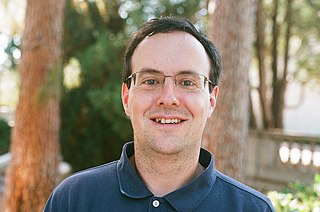In algebraic topology, a homology sphere is an n-manifold X having the homology groups of an n-sphere, for some integer . That is,
In mathematics, a 4-manifold is a 4-dimensional topological manifold. A smooth 4-manifold is a 4-manifold with a smooth structure. In dimension four, in marked contrast with lower dimensions, topological and smooth manifolds are quite different. There exist some topological 4-manifolds which admit no smooth structure, and even if there exists a smooth structure, it need not be unique.
The Hauptvermutung of geometric topology is a now refuted conjecture asking whether any two triangulations of a triangulable space have subdivisions that are combinatorially equivalent, i.e. the subdivided triangulations are built up in the same combinatorial pattern. It was originally formulated as a conjecture in 1908 by Ernst Steinitz and Heinrich Franz Friedrich Tietze, but it is now known to be false.
In mathematics, Khovanov homology is an oriented link invariant that arises as the cohomology of a cochain complex. It may be regarded as a categorification of the Jones polynomial.
In mathematics, Floer homology is a tool for studying symplectic geometry and low-dimensional topology. Floer homology is a novel invariant that arises as an infinite-dimensional analogue of finite-dimensional Morse homology. Andreas Floer introduced the first version of Floer homology, now called symplectic Floer homology, in his proof of the Arnold conjecture in symplectic geometry. Floer also developed a closely related theory for Lagrangian submanifolds of a symplectic manifold. A third construction, also due to Floer, associates homology groups to closed three-dimensional manifolds using the Yang–Mills functional. These constructions and their descendants play a fundamental role in current investigations into the topology of symplectic and contact manifolds as well as (smooth) three- and four-dimensional manifolds.
Peter Benedict Kronheimer is a British mathematician, known for his work on gauge theory and its applications to 3- and 4-dimensional topology. He is William Caspar Graustein Professor of Mathematics at Harvard University and former chair of the mathematics department.
In mathematics, the Weinstein conjecture refers to a general existence problem for periodic orbits of Hamiltonian or Reeb vector flows. More specifically, the conjecture claims that on a compact contact manifold, its Reeb vector field should carry at least one periodic orbit.

In mathematics, the unknotting problem is the problem of algorithmically recognizing the unknot, given some representation of a knot, e.g., a knot diagram. There are several types of unknotting algorithms. A major unresolved challenge is to determine if the problem admits a polynomial time algorithm; that is, whether the problem lies in the complexity class P.

Clifford Henry Taubes is the William Petschek Professor of Mathematics at Harvard University and works in gauge field theory, differential geometry, and low-dimensional topology. His brother is the journalist Gary Taubes.
The Oswald Veblen Prize in Geometry is an award granted by the American Mathematical Society for notable research in geometry or topology. It was funded in 1961 in memory of Oswald Veblen and first issued in 1964. The Veblen Prize is now worth US$5000, and is awarded every three years.
In mathematics, and especially gauge theory, Donaldson theory is the study of the topology of smooth 4-manifolds using moduli spaces of anti-self-dual instantons. It was started by Simon Donaldson (1983) who proved Donaldson's theorem restricting the possible quadratic forms on the second cohomology group of a compact simply connected 4-manifold. Important consequences of this theorem include the existence of an Exotic R4 and the failure of the smooth h-cobordism theorem in 4 dimensions. The results of Donaldson theory depend therefore on the manifold having a differential structure, and are largely false for topological 4-manifolds.
Zoltán Szabó is a professor of mathematics at Princeton University known for his work on Heegaard Floer homology.

Tomasz Mrowka is an American mathematician specializing in differential geometry and gauge theory. He is the Singer Professor of Mathematics and former head of the Department of Mathematics at the Massachusetts Institute of Technology.
This is a timeline of manifolds, one of the major geometric concepts of mathematics. For further background see history of manifolds and varieties.

Michael Lounsbery Hutchings is an American mathematician, a professor of mathematics at the University of California, Berkeley. He is known for proving the double bubble conjecture on the shape of two-chambered soap bubbles, and for his work on circle-valued Morse theory and on embedded contact homology, which he defined.
Kaoru Ono is a Japanese mathematician, specializing in symplectic geometry. He is a professor at the Research Institute for Mathematical Sciences (RIMS) at Kyoto University.
The E. H. Moore Research Article Prize, also called the Moore Prize, is one of twenty-two prizes given out by the American Mathematical Society (AMS). It recognizes an outstanding research article to have appeared in one of the AMS primary research journals during the previous six years. The prize was funded in 2002 in memory of the former AMS president E. H. Moore. Beginning in 2004, it is awarded every three years at the Joint Mathematics Meetings and carries a cash reward of $5,000.
Ronald Alan Fintushel is an American mathematician, specializing in low-dimensional geometric topology and the mathematics of gauge theory.
Dietmar Arno Salamon is a German mathematician.

Denis Auroux is a French mathematician working in geometry and topology.





